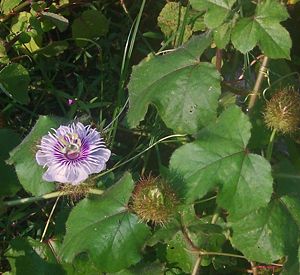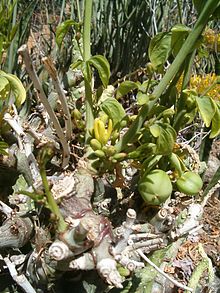Passifloroideae
| Passifloroideae | ||||||||||||
|---|---|---|---|---|---|---|---|---|---|---|---|---|

|
||||||||||||
| Systematics | ||||||||||||
|
||||||||||||
| Scientific name | ||||||||||||
| Passifloroideae | ||||||||||||
| Burnett |
The subfamily Passifloroideae part of the plant family passifloraceae (Passifloraceae) within the order of Malpighienartigen (Malpighiales). The genera of the former families of the Malesherbiaceae and Turneraceae have also been part of the Passifloraceae family since 2009. The subfamily is distributed worldwide in the tropics and subtropics , with a focus on Africa and the Neotropics .
description




Vegetative characteristics
The species of the subfamily Passifloroideae are woody plants: trees , shrubs and lianas , or climbing herbaceous plants . Climbing species have axillary tendrils.
The alternate and spirally arranged leaves are divided into a petiole and a leaf blade. The leaf blades are simple, incised or compound (palmate pinnate). There are extra-floral nectaries on the petioles. Stipules are often present. The mostly small stipules are not fused together and fall off early.
Generative characteristics
The flowers are individually in the leaf axils or usually few in lateral, zymous inflorescences . Under the flowers there are usually three bracts that form a calyx-like involucre .
In the species of the subfamily Passifloroideae, the flowers are mostly hermaphroditic. If the flowers are unisexual, then the plant specimens are dioeciously separated ( dioecious ).
The relatively large, radial symmetry flowers are three to eight, mostly five-fold. The bracts are usually divided into sepals and petals; sepals are rarely absent. The usually five (three to eight) sepals are durable and overlap like roof tiles. The mostly five (three to eight) petals are mostly free or rarely only fused at their base and overlap like roof tiles. There is often a free, often hollow flower base (hypanthium) and often a disc . Often an androgynophore or a gynophore is formed. There are five or 20 to 60 stamens , sometimes only part of them is fertile , 15 to 50 can be staminodes . The often intensely colored staminodes can be thread-like to scale-like and form one or more secondary crowns (coronae) or a ring. The ovary shorter or longer stalked. Most three (two to five) carpels have become a top permanent, single-chamber ovary grown. There are usually three parietal placentas with numerous ovules . There are one or mostly three (two to five) styluses with the same number of scars .
The species of the subfamily Passifloroideae form capsule fruits or berries . The seeds contain oily endosperm . The straight, chlorophyll-free embryo is well developed. The two cotyledons ( cotyledons ) are flat.
In the species of the subfamily Passifloroideae, the basic chromosome numbers are x = 6 or 9 to 11.
ecology
The species of the subfamily Passifloroideae are mesophytes or xerophytes .
The species of the subfamily Passifloroideae are pollinated by insects ( entomophilia ).
Systematics
The subfamily Passifloroideae was established in 1835 by Gilbert Thomas Burnett in Outlines of Botany, pages 750-1092, 1130. The type genus is Passiflora L.
In 2009 APG III incorporated the genera of the former families of the Malesherbiaceae and Turneraceae into the family of Passifloraceae s. l., which since then contains three subfamilies.
The subfamily Passifloroideae Burnett is divided into two tribes and contains a total of 16 genera with about 705 species:
- Tribe Paropsieae DC. : The roughly six genera with about 22 species are mainly distributed in Africa, only one species occurs in Southeast Asia :
-
Androsiphonia Stapf : It contains only one species:
- Androsiphonia adenostegia Stapf : In tropical Africa it occurs only in Guinea .
- Barteria Hook. f. : The fouror sospecies are distributed from Benin via the Democratic Republic of the Congo to western Tanzania .
- Paropsia Noronha ex Thouars : The approximately twelve species are distributed from Nigeria to Madagascar, only one species occurs in Southeast Asia.
- Paropsiopsis Engl .: The only two species occur from Cameroon to the western Congo (Kinshasa).
- Smeathmannia Sol. ex R.Br. : The only two species occur from Gambia to Cameroon.
-
Viridivia J.H. Hemsl. & Verdc. : It contains only one type:
- Viridivia suberosa J.H. Hemsl. & Verdc. : It occurs in tropical Africa in Zambia , Tanzania and in the Democratic Republic of the Congo.
-
Androsiphonia Stapf : It contains only one species:
- Tribus Passifloreae DC. : It contains about ten genera with a very wide distribution:
- Adenia Forssk. (Syn .: Blepharanthes Sm. Nom. Inval., Clemanthus Klotzsch , Echinothamnus Engl. , Erythrocarpus M. Roem . , Jaeggia Schinz , Keramanthus Hook. F. , Kolbia P.Beauv. , Machadoa Welw. Ex Hook. F. , Microblepharis (Wight & Arn.) M. Roem . , Modecca Lam. , Ophiocaulon Hook. F. , Paschanthus Burch. ): The 95 to 100 species are mostly East African succulents .
- Ancistrothyrsus Harms : The only two types are common in tropical South America.
- Basananthe Peyr. (Syn .: Carania Chiov. , Tryphostemma Harv. ): The 30 to 37 species are common in Africa.
-
Crossostemma planch. ex Benth. : It contains only one type:
- Crossostemma laurifolium Planch. ex Benth. : It occurs in tropical West Africa .
- Deidamia E.A. Noronha ex Thouars (Syn .: Thompsonia R.Br. ): The five or so species only occur in Madagascar .
-
Dilkea mast. : The sixor sospecies are distributed from Panama to tropical South America. Including:
- Dilkea high feuillet
- Dilkea nitens feuillet
- Efulensia C.H.Wright (Syn .: Giorgiella De Wild. , Sematanthera Pierre ex Harms ): The only two species are distributed in Central Africa from Nigeria to Uganda .
-
Mitostemma mast. : It contains only one type:
- Mitostemma glaziovii mast. : It occurs in Brazil .
- Passion flowers ( Passiflora L. , Syn .: Anthactinia Bory ex M.Roem. , Asephananthes Bory , Baldwinia Raf. , Ceratosepalum Oerst. , Cieca Medik. , Decaloba M.Roem. , Disemma Labill. , Granadilla Mill. , Hollrungia K.Schum . , Monactineirma Bory , Murucuja Medik. , Pentaria M.Roem. , Poggendorffia H.Karst. , Tacsonia Juss. , Tetrapathea (DC.) Rchb. , Tetrastylis Barb.Rodr. ): It has been divided into five sub-genera since 2003 and contains broadly about 525 species.
-
Schlechterina Harms : It contains only one species:
- Schlechterina mitostemmatoides Harms : It occurs in tropical East Africa in Kenya , Mozambique and Tanzania .
use
The berries of some species of the subfamily Passifloroideae are eaten or juice is extracted from them ( passion fruit / maracuja , grenadilla , barbadine , curuba ). Some species of the subfamily Passifloroideae are used as ornamental plants .
swell
- The family of Passifloraceae s. l. at the AP website . (Sections Description and Systematics)
- Description of the Passifloraceae family. st. at DELTA by L. Watson & MJ Dallwitz still in the old scope. (Section description of the family in the old scope)
- T. Nunes, 2009: Neotropical Passifloraceae. In: W. Milliken, B. Klitgård, A. Baracat: Neotropikey - Interactive key and information resources for flowering plants of the Neotropics. (Section description of the family in the old scope)
Individual evidence
- ↑ a b c d e f g h i j k l Description of the Passifloraceae family. st. in the case of DELTA by L. Watson, MJ Dallwitz still in the old scope, i.e. the subfamily Passifloroideae.
- ↑ Passifloroideae at Tropicos.org. Missouri Botanical Garden, St. Louis, Retrieved August 12, 2018.
- ↑ a b An update of the Angiosperm Phylogeny Group classification for the orders and families of flowering plants: APG III , in Botanical Journal of the Linnean Society , 2009, pp. 105-121.
- ↑ a b c d e f Passifloroideae in the Germplasm Resources Information Network (GRIN), USDA , ARS , National Genetic Resources Program. National Germplasm Resources Laboratory, Beltsville, Maryland. Retrieved August 12, 2018.
- ↑ a b c d e f g JM de Vos, FJ Breteler A revision of the African genera Paropsiopsis and Smeathmannia (Passifloraceae - Paropsieae), including a new species of Paropsiopsis from Cameroon. In: Edinburgh Journal of Botany , Volume 66, Issue 1, 2009, pp. 27-49. doi : 10.1017 / S0960428609005174 full text PDF.
- ^ C. Feuillet: Folia taxonomica 16. Dilkea (Passifloraceae) 1. Epkia, a new subgenus and five new species from western Amazonia and the Guianas. In: Journal of the Botanical Research Institute of Texas , Volume 3, 2009, pp. 593-604.
- ↑ Search for “Passifloraceae” in the IUCN Red List of Threatened Species .
Web links
- Passifloraceae at Tropicos.org. In: Catalog of the Vascular Plants of Madagascar . Missouri Botanical Garden, St. Louis
further reading
- Robert Hegnauer : Chemotaxonomie der Pflanzen - An overview of the distribution and the systematic importance of plant substances , Basel 1969, ISBN 978-3-0348-9391-6 . doi : 10.1007 / 978-3-0348-7985-9 Passifloraceae s. st. on pp. 293-298.
